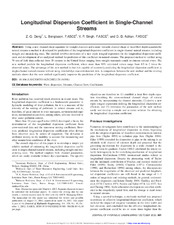| dc.creator | Adrian, D.D. | |
| dc.creator | Bengtsson, L. | |
| dc.creator | Deng, Z. Q. | |
| dc.creator | Singh, V. P. | |
| dc.date.accessioned | 2017-10-19T14:29:24Z | |
| dc.date.available | 2017-10-19T14:29:24Z | |
| dc.date.issued | 2002-10-01 | |
| dc.identifier.issn | 0733-9429 | |
| dc.identifier.uri | https://hdl.handle.net/1969.1/164669 | |
| dc.description.abstract | Using a new channel shape equation for straight channels and a more versatile channel shape or local flow depth equation for natural streams a method is developed for prediction of the longitudinal dispersion coefficient in single-channel natural streams, including straight and meandering ones. The method involves derivation of a new triple integral expression for the longitudinal dispersion coefficient and development of an analytical method for prediction of this coefficient in natural streams. The proposed method is verified using 70 sets of field data collected from 30 streams in the United States ranging from straight manmade canals to sinuous natural rivers. The new method predicts the longitudinal dispersion coefficient, where more than 90% calculated values range from 0.5 to 2 times the observed values. The advantage of the new method is that it is capable of accurately predicting the longitudinal dispersion coefficient in single-channel natural streams without using detailed dye concentration test data. A comparison between the new method and the existing methods shows that the new method significantly improves the prediction of the longitudinal dispersion coefficient. | en |
| dc.language.iso | en_US | |
| dc.subject | Wave dispersion | en |
| dc.subject | Streams | en |
| dc.subject | Channel flow | en |
| dc.subject | Coefficients | en |
| dc.title | Longitudinal Dispersion Coefficient in Single-Channel Streams | en |
| dc.type | Article | en |
| local.department | Biological and Agricultural Engineering (College of
Agriculture and Life Sciences) | en |
| dc.identifier.doi | 10.1061/(ASCE)0733-9429(2002)128:10(901) | |


